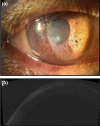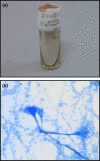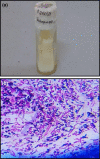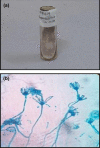Challenges in the diagnosis and management of atypical fungal keratitis during the COVID-19 pandemic: a case series
- PMID: 37691845
- PMCID: PMC10484319
- DOI: 10.1099/acmi.0.000570.v3
Challenges in the diagnosis and management of atypical fungal keratitis during the COVID-19 pandemic: a case series
Abstract
Fungal keratitis is a time-sensitive ocular infection that often requires a high index of suspicion followed by intensive medical/surgical interventions to achieve a successful clinical outcome. COVID-19 pandemic-related restrictions, necessitated the modification of conventional protocols and guidelines associated with the treatment of keratomycosis. We report four cases of atypical fungal keratitis with poorly differentiated clinical characteristics. The challenges faced during their management were (1) the dilemma of clinically differentiating fungal (Scedosporium and Purpureocillium lilacinum) and bacterial keratitis; (2) treatment of Scedosporium and Trichosporon keratitis with natamycin monotherapy; (3) mixed infection of Candida albicans and Aureobasidium pullulans and continuing medications before rescraping the corneal ulcer against the recommended treatment guidelines; (4) phenotypic identification and differentiation among morphologically resembling fungi; and (5) decision making arising out of disparities between KOH and fungal culture results. Three patients responded well to conservative treatments. The fourth patient underwent therapeutic keratoplasty but was lost to follow-up due to travel-related pandemic restrictions. This case series seeks to broaden the clinician's knowledge of rare and emerging moulds as presumptive aetiologies of keratomycosis. It also intends to emphasize the significance of early microbiological investigations, (direct microscopy and culture), in resource-limited settings, for initiating empirical treatment for a better visual prognosis.
Keywords: Atypical fungal keratitis; Aureobasidium; COVID-19; Purpureocillium; Scedosporium; Trichosporon.
© 2023 The Authors.
Conflict of interest statement
The authors declare that there are no conflicts of interest.
Figures






Similar articles
-
Aureobasidium pullulans keratitis.Clin Exp Ophthalmol. 2006 Apr;34(3):260-4. doi: 10.1111/j.1442-9071.2006.01201.x. Clin Exp Ophthalmol. 2006. PMID: 16671907
-
Scedosporium Keratitis: An Experience From a Tertiary Eye Hospital in South India.Cornea. 2016 Dec;35(12):1575-1577. doi: 10.1097/ICO.0000000000000969. Cornea. 2016. PMID: 27538191
-
Infectious Keratitis Caused by Rare and Emerging Micro-Organisms.Curr Eye Res. 2020 Jul;45(7):761-773. doi: 10.1080/02713683.2019.1708407. Epub 2020 Jan 8. Curr Eye Res. 2020. PMID: 31870176 Review.
-
[Scedosporium apiospermum-a rare pathogen of keratomycosis].Ophthalmologe. 2020 Dec;117(12):1225-1228. doi: 10.1007/s00347-020-01073-x. Ophthalmologe. 2020. PMID: 32125497 German.
-
Fungal keratitis: An overview of clinical and laboratory aspects.Mycoses. 2018 Dec;61(12):916-930. doi: 10.1111/myc.12822. Epub 2018 Jul 27. Mycoses. 2018. PMID: 29992633 Review.
Cited by
-
A Lateral-Flow Device for the Rapid Detection of Scedosporium Species.Diagnostics (Basel). 2024 Apr 19;14(8):847. doi: 10.3390/diagnostics14080847. Diagnostics (Basel). 2024. PMID: 38667492 Free PMC article.
References
-
- Chander J. Miscellaneous Mycoses, Related Topics. 3rd ed. New Delhi: Mehta Publishers; 2012. Textbook of medical mycology; pp. 400–409.
-
- Ahmadikia K, Aghaei Gharehbolagh S, Fallah B, Naeimi Eshkaleti M, Malekifar P, et al. Distribution, prevalence, and causative agents of fungal keratitis: a systematic review and meta-analysis (1990 to 2020) Front Cell Infect Microbiol. 2021;11:698780. doi: 10.3389/fcimb.2021.698780. - DOI - PMC - PubMed
-
- Farias R, Pinho L, Santos R. Epidemiological profile of infectious keratitis. Rev Bras Oftalmol. 2017;76:116–120. doi: 10.5935/0034-7280.20170024. - DOI
Publication types
LinkOut - more resources
Full Text Sources
